
HOW I PACKED FULL OVERNIGHT KIT INTO AN INOV8 RACE VEST!
Fell runner and wild camper Norman Hadley explores the outer reaches of ultralight fastpacking, squeezing a full overnight kit into a 5-litre INOV8 race vest. You heard that right, 5 litres!
How low can you go? It's a question that famously preoccupies limbo dancers, but it obsesses ultralight backpackers just as much. I'm far too old and creaky to duck under low bars, so this is the tale of how I developed an ultralight fastpacking setup instead.
WHAT IS FASTPACKING?
Not everyone warms to the word “fastpacking” but I’m yet to hear of a better alternative. “Micro-yomping”, anyone? Whatever you call it, it blends the self-sufficient freedom of the traditional backpacker with the light-footed, dancing step of the fell runner.
Immediately, there is tension. Because we’ve all seen traditional backpackers heading into the hills with 60, 70 or even 80-litre packs, shoulder-straps straining and veins bulging on their foreheads. The army might make you run with such a burden to break your spirit, but you wouldn't do it for pleasure.
Fell runners start from the other extreme, typically out for two or three hours, constantly on the move and working hard. Anything more than a singlet and shorts is overdoing it, according to some.
Bringing those disparate worlds together isn’t easy; difficult trade-offs must be made. But kit has become lighter in recent years, to the point where a modern fastpacking setup might squeeze into a 35-litre sack. That’s tiny from the traditional backpacker’s perspective, but still a significant pendulum to have on your back while running. I like to challenge myself, so I set out to squash everything I needed into 5 litres. No, that isn’t a typo. Did I mention I like a challenge?
THE RULES WHEN CHOOSING KIT
Assembling the kit, I imposed a few rules:
- It has to be a comfortable camping experience
If you just want an eye-catching number for your base weight, you could head into the hills with just a space blanket and blind optimism. But you’ll be miserable at best and, at worst, you’ll have a starring role in the mountain rescue team’s annual report. I like to have fun, and to be responsible, so that means a warm, dry night on a blow-up mat. - Focus on volume as well as weight
I needed to, with so little space available, but it also felt right. A “small is beautiful” mindset would get everything fitting sleekly to the body, feeling more like something worn than carried. - Acknowledge that everything is interdependent
Every item had to work as part of a system. So it’s no use having a warm sleeping bag if your mat leaks all of your warmth into the ground. You might find a tent that’s light and roomy, but what if the collapsed poles are too long for your bag?
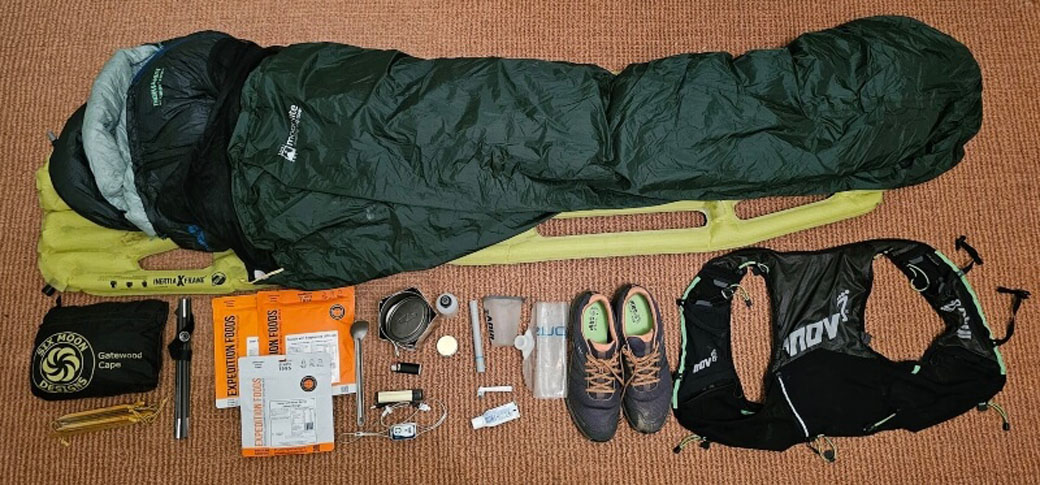
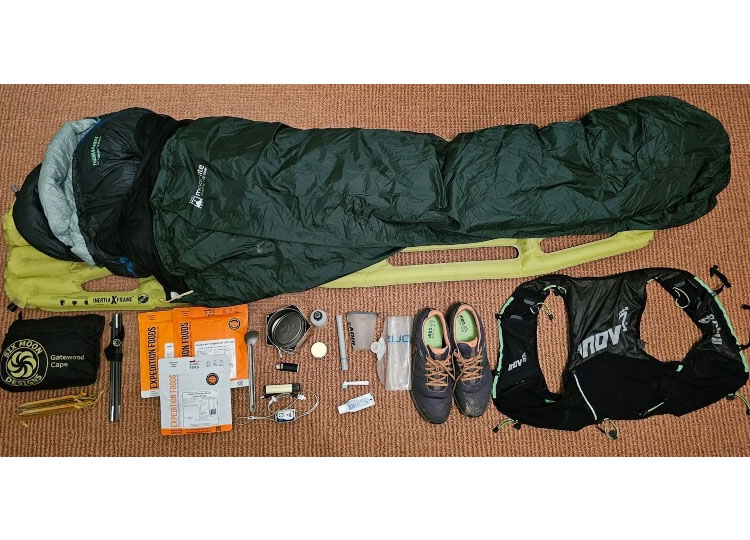
GETTING THE RIGHT PACK
The only thing in my favour was my focus on one-night outings, so I only needed 24 hours’ worth of food. But it was still going to be a tough assignment. I moseyed down to INOV8’s Forge store in Staveley and came away with an ULTRAPAC PRO 2IN1 vest.
The ULTRAPAC PRO 2IN1 is a very cunning, modular system that can be assembled in two different volumes. All together, it’s rated at 12 litres, with a removable 7-litre compartment. I reckoned the full capacity would work well for the winter variant but, for summer, the 5-litre base vest would serve.
Even without the clip-on 7-litre pouch, the vest is a fantastically versatile piece of kit, with a wealth of different compartments to squirrel away your gear. Load can be distributed evenly between the main back pouch, the underarm panniers and the shoulder straps. That makes it ride very comfortably and the shape of the thing hugs your back like a koala on a gum tree. Bounce is nigh-on undetectable. I've even run with both sternum straps undone, and it sat as still as an obedient collie.
HOW I PACK MY GEAR
I needed a sleeping bag that would provide 3-season usage. For conditions in the Lake District, a comfort rating of 5 degrees Celsius is about right for my size and metabolism. I picked Thermarest’s Hyperion 32 because it compresses down into an impressively packable shape. I squeeze it into a Dyneema pouch that’s actually designed for a sleeping mat. This will then go into the back pouch of the vest, which would more normally take a hydration bladder.
My cooking pot fits like a tin helmet on top of the sleeping bag, so it takes no extra space. The tent pole, which folds down short and weighs less than a Mars Bar, goes alongside.
The two underarm pouches take dry base layers for the night on one side and a sleeping bag cover (a Terra Nova Moonlite) on the other. I need this because my tent has neither an inner nor a groundsheet. I’ve found a flysheet-and-bivy combo the best solution because it gives me a generous living space out of the weather where I can sit upright. I can even cook under cover, as long as I’m careful to let the steam and fumes out. By contrast, many of the microtents and hooped bivis on the market offer space to sleep and nothing else. Even changing clothes inside looks impossible for anyone who isn’t a circus contortionist. Or a limbo dancer.
The mat I chose is a Klymit X-Frame. It’s a bizarre looking contraption but it’s exceptionally light and the argument goes that the bottom of the sleeping bag can loft into the voids, keeping your back warmer than it would be if you were lying on compressed down. It tucks into one of the shoulder straps, where a water bottle would more normally sit.
Into the other side goes the tent, a Six Moons Designs Gatewood Cape. That might sound hard to believe, squeezing a tent into a shoulder-pouch designed for a water bottle, but it works. Remember, it’s just a flysheet, so it squashes down into a very tight sausage. The trickiest parts to stow are the pegs, because you don’t want them ripping up your delicate kit. And you definitely don’t want to turn into a human shish kebab if you stumble while running. So the pegs are bagged and tucked into the stretchy pouch on one side.
Everything else is so small it can be squeezed into the remaining spaces. The pot lid and pot stand/windshield fold into the wallet-pocket in the small of the back. The stove, lighter and fuel bottle go into the zipped pocket on the shoulder strap. There’s still room for a power bank, toothbrush, toothpaste and a basic first-aid kit.
The sum total of that lot, including the race vest itself, is 2.2 kg. For older readers, that’s under 5 pounds, which puts it in a category known as “super ultralight”. The terminology might sound faintly ridiculous, but the upshot is an incredible sense of liberation. You're wearing a stripped-down vest, designed for a short day run, but you have the wherewithal to raise a shelter wherever you choose, cook a meal and bed down for the night.
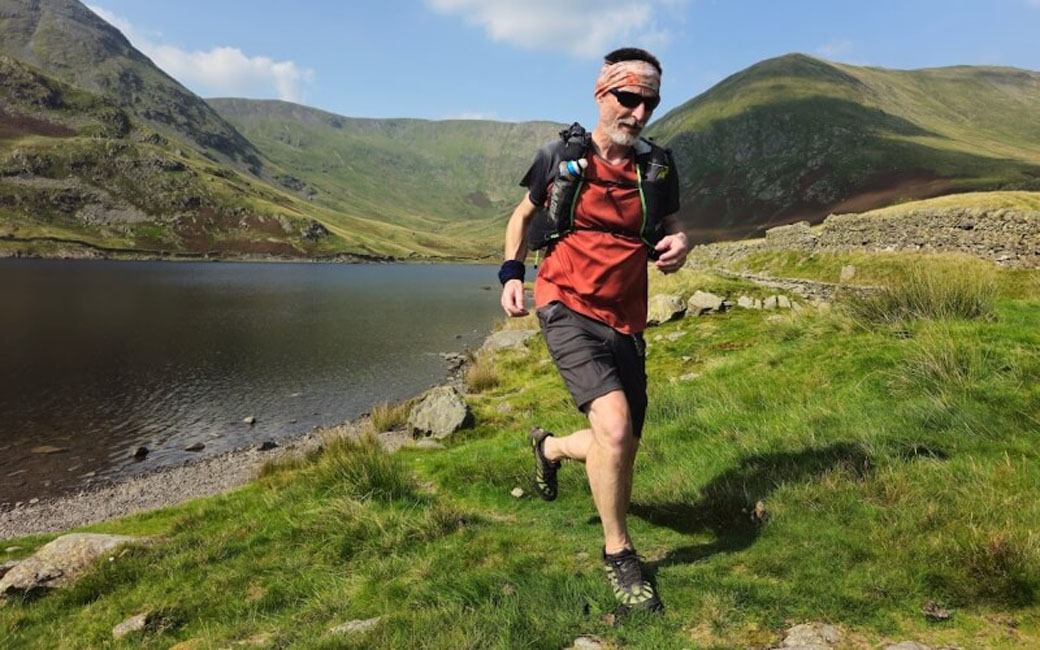
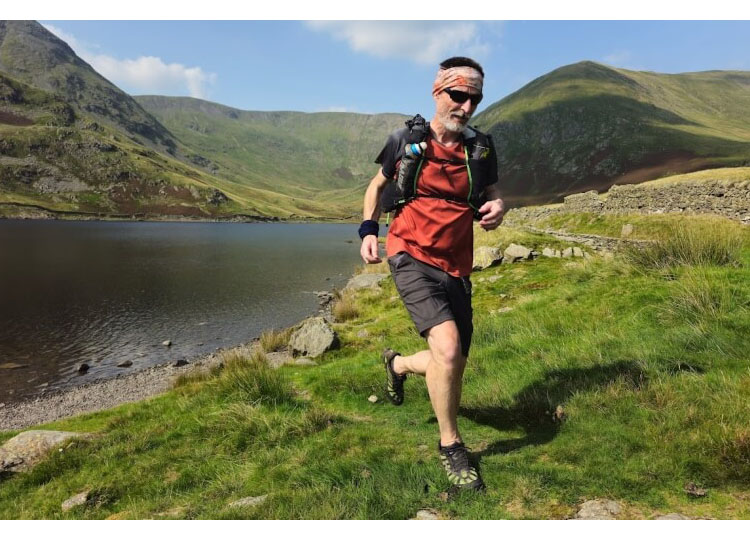
FOOD, GLORIOUS FOOD
Readers of this blog won’t need reminding that fell running burns a lot of calories. For the day-runner, it’s easy to fill up beforehand and afterwards, with just a few snacks or gels to sustain you on the go.
But if you throw in a wild camp, you need to be packing some serious calories. This can easily add a lot of weight so I use freeze-dried pouches. You can get main meals and breakfasts at 800 or even 1000 Calories. Puddings come in at 450 Calories. The effect of a good feed on camp morale cannot be overstated and even Oliver Twist wouldn’t need to come back for more.
A decent evening meal also boosts my metabolism at the right time to get a warm night’s sleep. A hefty breakfast and a pint of strong black coffee will hoist me out of bed on a dark morning by a cold summit cairn. These comforts are not to be neglected.
KEEPING DRY
I carry a full set of rainwear stuffed in the pockets of my shorts for easy access. That’s why they don’t count as base weight. The whole setup: waterproof jacket, overtrousers and mitts, comes in at just 200 grams.
STAYING HYDRATED
When you pare your weight right down, water is one of the first items to be jettisoned because it’s just too heavy and bulky. For the most part, the Lake District fells are not short of water sources.
So I carry a Hydroblu filtered drinking straw and the collapsible 500ml bottle that came with the vest. Whenever I cross a trickle in the hillside, a quick scoop-and-slurp and I’m on my way again. For in-camp cooking and serious hydration, I carry a 2-litre Platypus water pouch that folds into the shoulder strap of the vest.
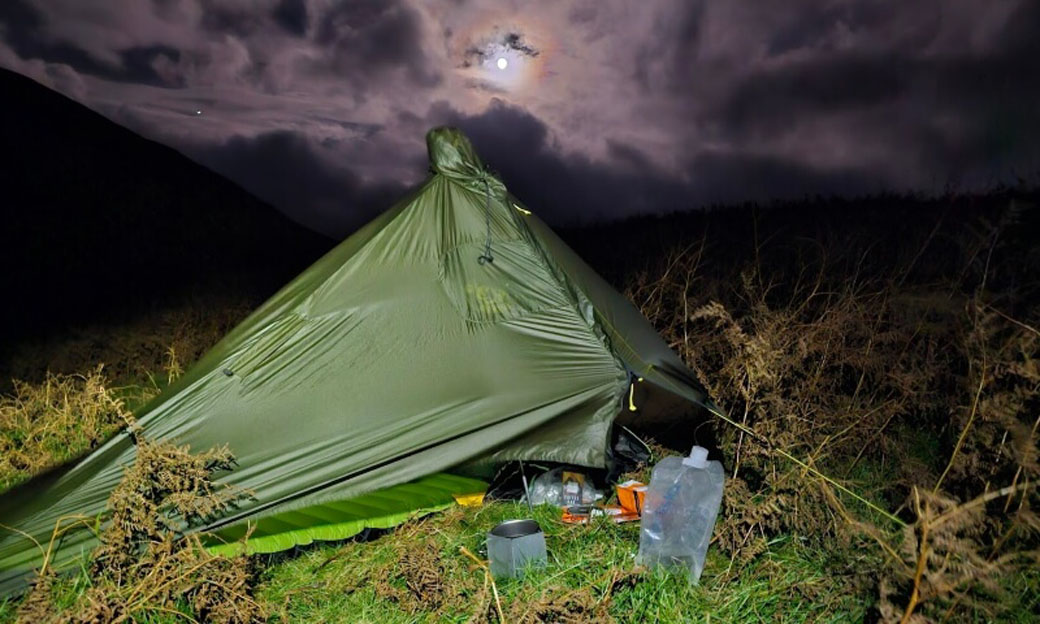
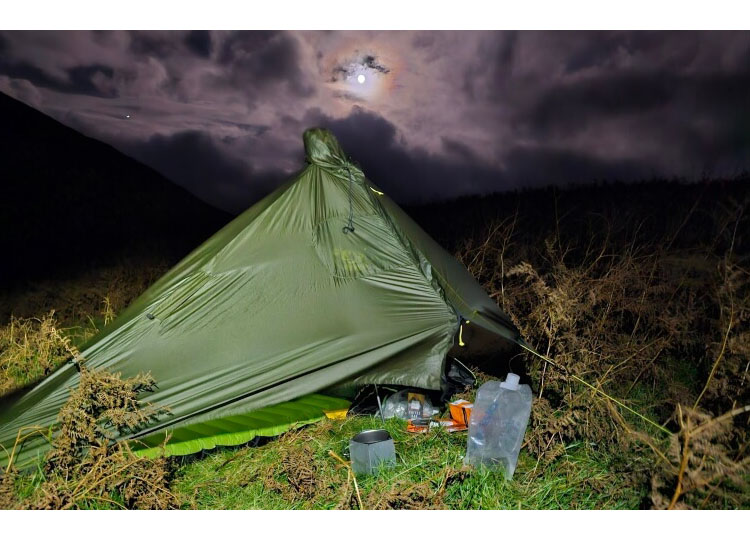
SAFETY
By anyone’s measure, this is a highly stripped-down setup and it requires serious thought before setting out into the hills so lightly clad.
I only use it in familiar settings. I’ve been roaming the Lakeland fells since the early seventies, so I know pretty much every boulder and tussock. I study the forecast and fell-condition reports obsessively for days before each trip. I’ve set up my phone so it constantly relays my position to my wife’s phone. If I lost signal in a dip in the landscape, she would at least have a “last known position”.
Even with such a pared-down setup, there is some carefully thought-through redundancy. For example, the flysheet can be worn as a cape for extra protection against wind, rain and cold. If the tent was flattened by high winds, the sleeping bag cover would still protect me. Yes, it would probably be an uncomfortable, sleepless night, but a survivable one.
AN ALL-TERRAIN MITT THROWN DOWN IN CHALLENGE
Devising and using this setup has brought me incalculable pleasure over the last two-and-a-half years. Although I’m now in my mid-fifties, this is proving a surprising golden age of innovation, adventure and discovery. I’ve honestly not felt so fulfilled by new mountain experiences since my early twenties.
I hope someone else out there feels inspired to see what they can do. At five pounds and five litres, I think I’ve set the bar pretty low. How low can you go?
